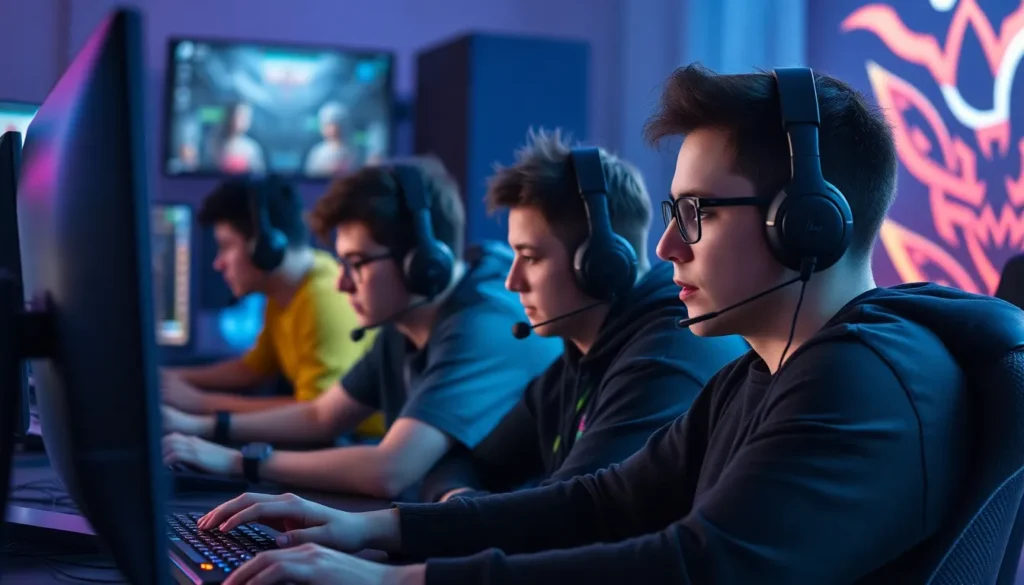Table of Contents
ToggleIn the fast-paced world of competitive gaming, split push tactics are like the sneaky ninja moves that can turn the tide of battle. Imagine sending one champion off to wreak havoc while the rest of the team distracts the enemy—it’s the ultimate game of cat and mouse. Not only does it keep opponents guessing, but it also creates opportunities for strategic advantages that can lead to victory.
Overview of Split Push Tactics
Split push tactics involve a strategic approach where one champion pushes a lane while the rest of the team occupies other areas. This tactic creates pressure by forcing opponents to respond to multiple threats. Sending a strong champion to a side lane can lead to tower takedowns, generating additional advantages.
Creating chaos through split pushing often draws enemy champions away from objectives, granting the team opportunities to secure dragons, barons, or other critical map areas. Each successful push disrupts the enemy’s formation, making it challenging for them to maintain control. Meanwhile, communication plays a key role; team members must coordinate their efforts to maximize the effectiveness of the split push.
Rewards come in the form of map control and increased resources. With proper execution, the split push can lead to establishing vision and creating advantageous team fights. Engaging while the enemy is occupied with the split pusher often results in favorable outcomes.
Champion selection significantly influences the success of a split push. Champions with mobility or escape abilities excel at harassing opponents while evading danger. Teams should also consider the timing; initiating a split push when the enemy team is outnumbered or distracted heightens the chances of success.
Failure to communicate or understand the risks can lead to disastrous consequences. Overcommitting to a split push without support may result in being caught and turned into unfavorable trades. Balancing aggression with caution ensures that a split push remains an effective tactic throughout the game.
Key Elements of Split Push Tactics

Understanding the key elements of split push tactics helps to maximize their effectiveness during a match. The focus lies on strategic champion selection and heightened map awareness.
Champion Selection
Choosing the right champion enhances the success of split push tactics. Champions with high mobility or strong escape abilities fit seamlessly into this strategy. Examples include champions like Zed or Riven, as their potential for quick movements creates opportunities for disengagement. Champions with wave clear capabilities also play a vital role; turning minion waves quickly allows for effective lane management. Prioritizing those champions simply increases pressure on enemies, forcing them to react and divide their attention. Selecting champions that can duel effectively ensures that the split pusher can defend against enemy threats when necessary.
Map Awareness
Map awareness stands as a critical component of executing split push tactics. Knowing the whereabouts of enemy champions helps avoid potential ambushes. Observing the mini-map consistently allows players to gauge enemy movements and make informed decisions. Recognizing when opponents commit to objectives also provides opportunities to pressure other lanes. Communicating with team members ensures coordination and appropriate timing during engagements. Keeping an eye on vision control prevents unexpected surprises, maintaining safety during the push. Reacting to information gathered from the map can drastically influence the pace and effectiveness of the split push, securing essential objectives and creating advantages.
Advantages of Split Push Tactics
Split push tactics create varied advantages in competitive gaming. These benefits significantly enhance a team’s chances of victory.
Pressure on Multiple Lanes
Pressure on multiple lanes disrupts enemy formations. By sending one champion to push a specific lane, opponents face the dilemma of responding to multiple threats simultaneously. When the enemy dedicates resources to defend against the split push, openings arise for the rest of the team to seize objectives elsewhere. This pressure often leads to advantageous trades, including tower takedowns and map control. For example, if an enemy team splits its forces to counter the split push, it can become vulnerable to a coordinated attack elsewhere. Consequently, split pushing can effectively stretch the enemy’s defenses and create opportunities for significant advantages.
Resource Allocation
Resource allocation becomes increasingly vital during split push tactics. A team can force opponents to allocate more champions to defend, which limits their ability to contest objectives like dragons or barons. As enemies divert attention and resources, the team executing the split push can gain an economic edge. This shift allows for additional gold and experience, crucial for scaling champions throughout the match. Further, the splitting of resources can weaken the enemy team, making it easier to secure kills or map control. Organization leads to superior resource management, fostering a stronger competitive position.
Disadvantages of Split Push Tactics
Split push tactics, while effective, do come with specific disadvantages that can impact a team’s strategy.
Vulnerability to Ambushes
Ambushes can easily dismantle a split push. A lone champion pushing a lane might become isolated and vulnerable, especially if enemies coordinate to collapse on them. Moreover, if opponents possess strong crowd-control effects, they can hinder escape options. The chance of being caught out increases significantly when teammates aren’t present to provide backup. Vision control plays a crucial role in mitigating this risk, but it remains a challenge if the team lacks wards in key areas. Champions like Zed or Riven can quickly find themselves overwhelmed if they’re not cautious, highlighting the importance of maintaining awareness of enemy positions.
Requires Strong Communication
Effective communication is vital for executing split push tactics successfully. Team members must coordinate their movements to prevent isolation during a push. The risk of an unsuccessful push escalates with poor communication. If one player pushes too aggressively without informing others, that player may face unfavorable odds alone. Additionally, teammates need to understand when to engage and when to retreat to prevent losing advantageous positioning. Regular updates on enemy locations and intentions can ensure everyone is aligned. Achieving successful outcomes through a split push demands synergy between players, emphasizing the necessity of open dialogue during gameplay.
Mastering split push tactics can be a game-changer in competitive gaming. This strategy not only creates pressure across multiple lanes but also forces opponents into difficult decisions. With the right champion selection and effective communication, teams can exploit enemy weaknesses and secure vital objectives.
However, players must remain vigilant to avoid ambushes and maintain vision control. Balancing aggression with caution is essential to maximize the effectiveness of this tactic. By understanding the nuances of split pushing, players can enhance their overall gameplay and significantly improve their chances of victory.



